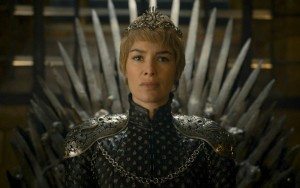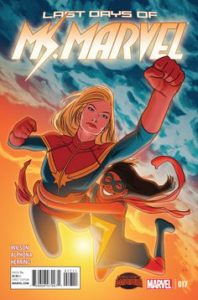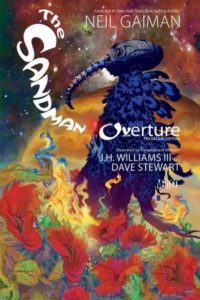We have previously taken a look at the games, novels, and more novels that won the inaugural Dragon Awards. Now, WWAC concludes its overview by examining the winners in the comic and moving pictures categories. Join Ardo Omar, Megan Purdy, and Doris V. Sutherland as they take a closer look at a batch of fan favorites.
 Best Science Fiction or Fantasy Movie
Best Science Fiction or Fantasy Movie
The Martian
Reviewed by Doris V. Sutherland
In contrast to the somewhat farcical literary brackets, the film and television categories show the Dragon Awards living up to their promise of being a celebration of the popular successes in SF and fantasy. The film ballot had no shortage of big blockbusters, and it was The Martian that came out on top.
By now, this tale of one man’s survival on a desolate planet needs little adaptation. Based on an originally self-published novel by Andy Weir–something which adds an additional one-person-against-the-odds factor to the story–the film was beloved by audiences and critics alike, demonstrating that harder SF can exist on-screen alongside such fanciful fare as Star Wars.
The main character is Mark Watney, an astronaut on a Mars mission whose comrades wrongly believe him to have been killed when he was separated from them in a storm. As the others head back to Earth, he is forced to scrape together what he can to survive alone on the red planet.
On one level The Martian offers a science fiction twist on Robinson Crusoe, an oft-used concept that goes back as far as Jules Verne. Watney’s adventures are a tale of optimism in the face of adversity, for while he suffers setbacks, there is simply no room for doubt or defeatism if he is to survive.
Watney’s relentless can-do drive is contrasted with the rather more complex state of affairs back on Earth. When NASA deduces from satellite photos that Watney is still alive on Mars, they are forced with a number of pressing issues. The most obvious involves getting him back; a more subtle problem is how to reveal his survival while maintaining public relations. The fact that the other astronauts are still en route to Earth complicates matters further. Can NASA tell them about Watney without breaking their concentration on their mission home?
A key reason why The Martian is such a satisfying film is that its two main plot threads operate on different yet complementary levels. The story of Mark Watney celebrates the will and ingenuity of an individual, while the story of his NASA comrades derives drama from the tough decisions that have to be made when a group of hard-minded individuals work together.
In the end, both parties come together in unison to pull off their mission, just as everything in the film comes together to create an instant classic of field of science fiction film.
 Best Science Fiction or Fantasy TV Series
Best Science Fiction or Fantasy TV Series
Game of Thrones
Reviewed by Megan Purdy
Season six of Game of Thrones represents a remarkable shift for cable television’s most miserable fantasy epic. It is, of course, the first season in which the show’s writers have gotten ahead of G.R.R. Martin’s unnecessarily long A Song of Ice and Fire books, which serve as the source material for the show. Martin’s struggles with the unwieldy plot and cast of characters he created in ASoIAF are well documented. Each book comes a little slower, with a few more point of view characters added, and with less and less plot momentum.
Game of Thrones too suffered from not-going-anywhere-itis, with many mid-season episodes feeling like filler, just the same old same old backstabbing, sexual violence, and slow moving schemes that would eventually exploding into season ending excitement. But in season six, where the writers finally paced and exceeded Martin–although they continue to work from his notes about the general direction of the series and the fates of its many, many characters–Game of Thrones finally shook off the last of its plot molasses. Season six moved swiftly, with big political moves being made in each episode, whereas in previous seasons viewers wait a whole season for a minor revelation, or a character to make the simplest of decisions, or for the various Starkling’s endless hike across Westeros to pay off with blood or even bunions.
But even more importantly, in season six the show seemed to experience a creative renewal and a shift of ethos. No longer a game of unworthy kings, now the focus was on a new game of queens, as characters like Sansa Stark, Cersei Lannister, Daenerys Targaryen, and Yara Greyjoy solidifying their grips on power and relied less on male allies. It sees Cersei shake off a season of abuse from the High Sparrow and marginalization by her uncle and son to seize the Iron Throne for herself. It also sees Dany ally with Yara Greyjoy and begin the ocean voyage to Westeros. That Dany will be battling a queen and not one of Westeros’ many terrible kings is a happy surprise, given how much time the show has spent, from Robert to Joffrey to Stannis to Balon, on their ambitious failures.
Jon Snow, the newly crowned zombie king of the North, is the only survivor of the five year war of kings, and he started the show as an afterthought, a neglected bastard sent away to join the ragtag guardian’s of the northern wall, the Night’s Watch. After years of being Jon Snow, You Know Nothing, thrust from one terrible adventure to another at the cusp of winter’s arrival in Westeros, along with its ice zombie army, being elected leader of the Night’s Watch only to be immediately assassinated, he finally landed back in his “father’s” castle, as its new ruler. That he stands now as the North’s new king, only with half-“sister” Sansa’s firm support and advice (which you should take more often, Jon, you fool), is a minor disruption of Westeros’ old patriarchal power structure, but one that’s easier to take when Cersei, Dany, and Yara have taken such prominence.
What is of more significance, of course, is that women have taken the reigns of power, but also that they took up an exponentially greater portion of the show’s screen time with stories that firmly passed the Bechdel test. Like so many cable dramas, it took Game of Thrones a little while to realize that every one of its female characters is interesting in her own right. That they have an inner life, ambitions, and affections entirely separate from the men surrounding them and from the suffering that the five previous seasons of the show leveled on them.
That’s not to say that Game of Thrones entirely squandered its female characters for five agonizing years–Dany and Arya are both compelling characters who have been fan favorites since the first episode aired in April 2011–but characters like Sansa and Cersei have long been less popular with the fans, being “the victim” and “the bitch.” The blame for fan antipathy lies solely on the show’s writers and directors, who often seemed to hate their minor and major female characters and delight in depicting their abuse and degradation. I don’t think it’s a stretch to say that Game of Thrones made it easier to like Arya and Dany (for a given value of “easier”) because of the writer’s own biases. Game of Thrones has been, until recently, more interested in women’s pain than women’s lives. A few cool girls who largely escaped those famously long sequences of humiliation and degradation (a whole season of sexualized torture, a minutes long nude walk through the streets of King’s Landing being shamed, etc.) seemed to occupy all of the show’s allotment of real empathy.
Game of Thrones has sympathy for all of its suffering characters, but empathy, understanding, and complexity have been, until recently, reserved for its male and a select few female characters. Their adventures were allowed to be endearing, as well as painful. Their mistakes were allowed to be understandable tragedies caused by fatal flaws, as well as circumstance. In contrast, Sansa was long a living, breathing misery magnet, and Cersei, a selfish, scheming wretch. Not to mention the dozens of women who have walked into the show in scant garments, been brutalized, allowed to deliver a pithy line or two, and then crawled out, if they even managed to survive the experience. In season six, this changed, and I don’t think it’s surprising that the shift came at the same time that the writers were decoupled from G.R.R. Martin’s books. Is it easier for Game of Thrones to imagine a whole women when she is a woman of action or power? Or perhaps it’s more important to ask, is it easier for men to imagine women as complete beings when men are not busy hurting them?
Women have always been integral to the long game that is the show’s meandering plot and to the immediate episode to episode dramas, but their importance has rarely been understood and respected by the show’s staff. It seems fitting that Game of Thrones won an award for the season where they finally did get it, where the female characters came to the forefront, both in terms of inhabiting positions of power and in terms of occupying the screen, finally given the depth and breadth of attention they deserve.
But what rankles about season six being so good is that it comes after five years of brutality and neglect. Of course, not every plot point involving a girl or woman involved rape, but an alarming number of them did. One grows to expect threatening men, objectification, and casual depictions of violence against women. And when it comes to characters like Cersei and Sansa, season six’s creative renewal is a bit sour, tasting too much of that old adventure story trope of abuse being a necessary ingredient for the rise of strong women. Certainly it’s delightful to see Cersei and Sansa at their scheming best, or to see Dany again rise from the literal ashes of patriarchal containment, but why did they have to suffer to be strong?
 Best Comic Book
Best Comic Book
Ms. Marvel
Reviewed by Ardo Omar
Ms. Marvel has been the only Marvel comic that I still read. I collect it in trades and await eagerly for the next volume to make its way to me. It’s a comic that continually surprises me–a Muslim woman of colour–in the best way possible.
In the issues published during the award’s eligibility period, Kamala gets to have a crush, deals with betrayal, gets courted by an extremist inhuman group, comes face-to-face with the end of the world, and balances school life with life as an Avenger. She comes to understand that Ms. Marvel doesn’t really belong to her anymore as a public figure and realizes what justice looks like when given the power to stop crime before it happens.
Kamala has lived a full life as a superhero, but she’s still a teenager. She’s a brown Muslim teenager, and it’s made her story fresh and exciting. G. Willow Wilson’s scripts are fantastic, and Adrian Alphona’s art has convinced me of Kamala’s particular brand of youthful exuberance, such as her wild brown hair and exaggerated expressions. There have also been fill in artists–Takeshi Miyazawa, Nico Leon, and Elmo Bondoc–who’ve all kept up the teen feel of the book. In fact, Takeshi Miyazawa was the artist on the teen Mary Jane limited series, so he’s right at home here.
We’re watching Kamala face difficult decisions and experience hardship, but in a way that helps the character grow even in spite of the back-to-back events that seem to want to derail books like this one. I’ve been enjoying my reading experience so far and can’t wait for me.
 Best Graphic Novel
Best Graphic Novel
The Sandman: Overture
Reviewed by Doris V. Sutherland
In a scarcely surprising turn of events, the poll-topper for Best Graphic Novel was the latest entry in one of the most influential comic series of all time: Neil Gaiman’s The Sandman. With The Sandman: Overture, Gaiman teams up with illustrator J. H. Williams III and colourist Dave Stewart to recount an adventure Morpheus had before becoming trapped on Earth at the very start of the series.
Equal parts prequel, epilogue, and side story, Overture explores horizons simultaneously broader and narrower to those of the main Sandman series. It’s broader because Gaiman explores areas of his multiverse not even hinted at in earlier volumes, including, among other things, the Endless have a father who lives in a nexus between potential realities and a mother who can be visited from within a black hole. It’s narrower because the story lacks a key part of the earlier volumes: interplay between the fantastic and the mundane.
The whole point of the original Sandman series was that its characters slipped freely between lands of dream and myth, and the everyday world of flats, diners, and popular playwrights. Overture makes some brief diversions to the human world, but its main plot–which involves an anthropomorphic star going insane and threatening the entire universe–is clearly on a different level to (say) Rose finding that one of her flatmates is a drag queen.
This does not come across as an oversight on Gaiman’s part, as he appears to be deliberately avoiding humans in this story. While he gives Dream a mortal companion–a girl named Hope–he makes her a blue-skinned humanoid alien, in a seeming acknowledgment that this Sandman story is simply not about the mundane world.
There is another indication that, with Overture, Gaiman is taking a step back from his creation. It is immediately obvious simply from opening the book. Like Endless Nights, another late entry in the series, Overture is an artist’s rather than a writer’s comic.
Illustrator J. H. Williams III has not created just one fantasy world but a whole array of them. The comic freely slides from one reality to another, each one signified by a distinct visual style. Dream’s father Time exists among Art Nouveau stylings, the same kind appropriated by 1960s psychedelia; elsewhere, we catch a brief glimpse of a moody sci-fi world straight out of Heavy Metal, while Earth remains rooted in the Gothic mode. The panel layouts are similarly organic, growing and shifting from page to page, and ensuring that all of the scenes have narrative life: they are more than still illustrations.
What Neil Gaiman provides for all of this is the emotional energy that runs through the story. The resulting book is in many ways totally different to the main Sandman series, and yet, the spirit behind it all is as familiar as an old friend.

